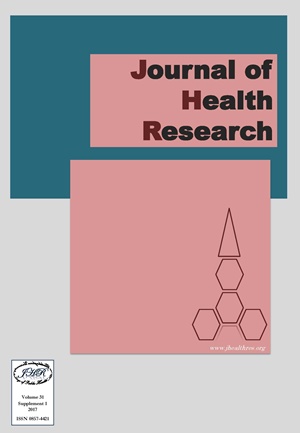Association between Occupational Chemical Exposure and Acute Health Symptoms among Bangkok Vector Control Operators, Thailand
Keywords:
Occupational chemical exposure, Acute health symptoms, Vector control operatorsAbstract
Backgrounds: Vector control operators (VCOs) play an important role in controlling vector-borne disease. However, they face occupational risks due to use of pesticides and exposure to chemicals. The purpose of this study was to assess the occupational risks faced by VCOs as a result of exposure to chemicals and the relationship between workers' acute health symptoms and exposure to chemicals among VCOs in Bangkok, Thailand.
Methods: A cross-sectional study was conducted in six areas within the Bangkok Metropolitan Administration (BMA) area among 96 male VCOs. General participant data including personal behavior, environmental working conditions, and health symptoms were collected via questionnaires. Cypermethrin, benzene, and toluene exposure data was collected through personal solid sorbent sampling during the time that chemicals were sprayed. Urine samples were collected for o-cresol and t,t-muconic acid (tt-MA) analysis at the end of the shift. Urine samples were also collected in the morning for biological monitoring of cypermethrin. Descriptive statistics and multiple logistic regressions were used.
Results: The average participant age was 41.76±10.21 years (mean ± SD). The average level of personal exposure to cypermethrin was 0.91±0.38 mg/m3 or 0.005±0.002 ppm. The level of 3 phenoxybenzoic acid (3 PBA), a metabolite of cypermethrin, was 5.00±2.42 ug/g creatinine. The exposure level of benzene was 0.120±0.86 mg/m3 or 0.37±0.26 ppm, a figure greater than the National Institute for Occupational Safety and Health (NIOSH) recommendations (NIOSH REL) Ca TWA 0.1 ppm. The level of tt-MA, its metabolite in urine, was 15.75±7.54 ug/g creatinine. Working exposure levels of toluene was 0.228±0.057 mg/m3 or 0.06±0.01 ppm from mixing of diesel fuel. O-cresol was 159±8.38 mg/g creatinine. The results demonstrated that facial irritation, blurred vision, fatigue, and nausea were significantly associated with airborne biomarkers. Irregular use of personal protective equipment (PPE), especially when spraying indoors (OR 1.46, CI 0.52-4.67, p<0.05), and poor use of PPE among operators lead to increase health risks of VCOs (OR 6.08, CI 1.61 22.9, p<0.05).
Conclusions: The findings suggest that a program of chemical safety program training should be implemented to reduce chemical exposure and symptoms among VCOs.







